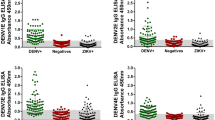Abstract
Porous silicon is an adaptable platform for developing label-free biosensors with high sensitivity and low cost. Dengue viral infection is detected based on commercially available ELISA (Enzyme-linked immunosorbent assay) based serological assays and not on the more difficult and costly procedures of Haemagglutination inhibition (HI), virus isolation or RT-PCR (Real Time polymerase chain reaction). In this paper, a novel diagnostic method for the detection of Dengue virus has been developed because it is still blooming and is becoming a major health concern around the world. Fabrication of a silicon wafer to create a Porous Silicon Microcavity (PSMC) has been used to increase the surface area for the immune reaction and hence the probability of the Dengue virus detection after chemical modification with adhesives and bio-functionalization is high by the treatment of antibody and antigen. Finally, a specific antigen-antibody reaction was obtained.
Similar content being viewed by others
References
Gubler DJ (1997) Dengue and dengue hemorrhagic fever. In: Seminars in Pediatric Infectious Diseases. Elsevier
Sathish N et al (2003) Dengue fever: Its laboratory diagnosis, with special emphasis on IgM detection. Dengue Bull 27:116– 125
Vázquez S et al (2003) MAC-ELISA and ELISA inhibition methods for detection of antibodies after yellow fever vaccination. J Virol Methods 110(2):179–184
De Paula SO, Fonseca BALD (2004) Dengue: a review of the laboratory tests a clinician must know to achieve a correct diagnosis. Braz J Infect Dis 8(6):390–398
Xu H et al (2006) Serotype 1-specific monoclonal antibody-based antigen capture immunoassay for detection of circulating nonstructural protein NS1: implications for early diagnosis and serotyping of dengue virus infections. J Clin Microbiol 44(8):2872–2878
Gubler DJ (1999) Dengue/dengue haemorrhagic fever: history and current status. In: Novartis foundation symposium 2006. John Wiley, Chichester
Young PR et al (2000) An antigen capture enzyme-linked immunosorbent assay reveals high levels of the dengue virus protein NS1 in the sera of infected patients. J Clin Microbiol 38(3):1053–1057
Alcon S et al (2002) Enzyme-linked immunosorbent assay specific to Dengue virus type 1 nonstructural protein NS1 reveals circulation of the antigen in the blood during the acute phase of disease in patients experiencing primary or secondary infections. J Clin Microbiol 40(2):376–381
Lin VS-Y et al (1997) A porous silicon-based optical interferometric biosensor 278(5339):840–843
Patel P, Mishra V, Panchal A (2012) Nano porous silicon microcavity optical biosensor device for glucose detection. Dig J Nanomater Biostructures (DJNB) 7(3):973–982
Patel PN, Mishra V, Panchal AK (2012) Nano scale porous silicon microcavity optical sensor device for the detection of methyl parathion. Digest J Nanomater Biostructures (DJNB) 7(4):1817–1823
Patel P et al (2013) Nanoscale porous silicon photonic microcavity structures for optical sensing of ethanol. Armenian J Phys 6(2)
Patel P, Mishra V (2012) Simulations and analysis of nano scale porous silicon structures for optical sensor applications. Int J Comput Appl 56
Patel P, Mishra V, Panchal A (2012) Synthesis and characterization of nano scale porous silicon photonic crystals for optical device and sensing applications. J Optoelectron Biomed Mater Vol 4(1):19–28
Singh M (2012) Dengue NS1 Detection using Chemically Modified Silicon Micropillars, 2012, University of Alberta
Patel P, Mishra V, Panchal A (2012) Theoretical and experimental study of nanoporous silicon photonic microcavity optical sensor devices. Adv Nat Sci Nanosci Nanotechnol 3(3):035016
Halimaoui A (1993) Electrochemical and chemical behavior of porous silicon layers: the role of the material wettability and its high specific surface area. In: Optical Properties of low dimensional silicon structures. Springer
Bardaoui A et al (2010) Porous silicon optical microcavity for chemical sensing application using tris-(8-hydroxyquinoline) aluminum (Alq3). Eur Phys J Appl Phys 51(03):30701
Author information
Authors and Affiliations
Corresponding author
Rights and permissions
About this article
Cite this article
Mishra, V., Patel, P.N., Kumari, S. et al. Dengue NS1 Detection used Chemically Modified Porous Silicon Microcavity (PSMC). Silicon 8, 401–407 (2016). https://doi.org/10.1007/s12633-014-9268-1
Received:
Accepted:
Published:
Issue Date:
DOI: https://doi.org/10.1007/s12633-014-9268-1




